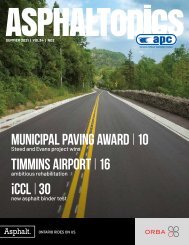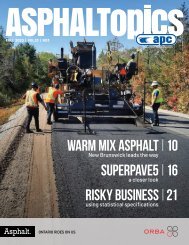ASPHALTopics | Spring 2020 | VOL 33 | NO 1
Create successful ePaper yourself
Turn your PDF publications into a flip-book with our unique Google optimized e-Paper software.
themselves.” Investing in research through OAPC and CPATT<br />
is a smart strategy for Ontario’s asphalt pavement industry,<br />
especially now that UW/CPATT is planning to initiate a new longterm<br />
research alliance to spearhead projects under the wide<br />
‘Road Building’ umbrella.<br />
Donations to CPATT give private companies a bigger bang<br />
for their buck since these funds are typically matched by<br />
government agencies: for every $1,000 invested, the company<br />
gets $2,000 in R&D value. As well, the University of Waterloo<br />
supports CPATT such that the organization has zero reduced<br />
overhead. This means that the money goes directly to research<br />
projects and paying the UW undergraduate/graduate students<br />
who work on them.<br />
“Hiring UW students gives them personal experience in helping<br />
us tackle some serious issues,” says Dr. Tighe. “This includes<br />
better incorporating sustainability into industry practices,<br />
improving recycling and material characterization, and preparing<br />
the industry and its practices to deal with climate change.”<br />
Another benefit to the asphalt industry is that the UW students<br />
who work on CPATT projects become the skilled professionals<br />
that the industry needs. OAPC’s Doubra Ambaiowei is one such<br />
student — a UW PhD graduate who worked with CPATT.<br />
“Dr. Ambaiowei is a former student of mine who studied<br />
rubberized asphalt with CPATT,” Dr. Tighe says. “So are many<br />
senior people in the Ontario asphalt industry, both in the private<br />
and public sectors. In fact, I’d say CPATT’s biggest impact has<br />
been in training and educating successful leaders who are<br />
moving up in the industry.”<br />
THE IMPORTANCE OF ARF/CPATT GOING FORWARD<br />
In a very real sense, OAPC’s Asphalt Research Fund and CPATT<br />
are a critically important team jointly serving the needs of the<br />
Ontario asphalt industry.<br />
In association with government and the private sector, ARF helps<br />
provide the money to underwrite CPATT’s research and the talent<br />
it is training for the industry. In turn, this talent is bringing the<br />
cutting-edge knowledge they’ve gained by working with CPATT<br />
to Ontario asphalt pavement companies.<br />
This infusion of new ideas comes at a time when the industry<br />
is undergoing fundamental change. Considerations such as<br />
premature aging, adding RAP, and developing sustainable<br />
practices for constructing and maintaining pavements weren’t<br />
issues when the Babylonians laid the first asphalt roads in<br />
625 BCE.<br />
Today, these issues and others are changing the world in which<br />
asphalt pavement companies must operate, which is why ARF<br />
and CPATT are more important than ever. This is why OAPC<br />
continues to support CPATT’s research efforts and urges its<br />
member companies to do the same. After all, knowledge is<br />
both power and profit — and CPATT is the industry’s best<br />
path to both.<br />
James Careless is an Ottawa-based freelance writer with credits<br />
in the National Post, Toronto Star, and AI’s Asphalt magazine.<br />
Bus Rapid Transit (BRT) lanes are built or being built along<br />
the three most heavily travelled roads in York Region: Yonge<br />
Street, Highway 7 and Davis Drive.<br />
To improve the level of safety through enhanced visibility<br />
and help residents and motorists easily understand this new<br />
transit system and follow the right-of-way, York Region has<br />
used a coloured asphalt surface course. Using coloured<br />
asphalt is an innovative technique that has its own unique<br />
challenges.<br />
A key to proper management of BRT lanes for York Region<br />
is to identify innovative and sustainable future maintenance<br />
and rehabilitation solutions that can be effectively used<br />
as a means of ensuring durability and high performance<br />
throughout the material’s life cycle. York Region and<br />
Metrolinx retained CPATT to provide an assessment on<br />
the performance of the in-situ materials and its expected<br />
long-term behaviour.<br />
Materials collected during paving operations and materials<br />
produced under controlled laboratory conditions were<br />
systematically evaluated at CPATT’s state-of-the-art<br />
pavement laboratory to capture the impact of colouring<br />
pigment on the mixture’s strength. This research is expected<br />
to provide reliable guidance for future usage of the material<br />
within Ontario and Canada.<br />
“Our work with CPATT has been a great example of a true<br />
partnership. York Region and Metrolinx have been moving<br />
forward with a Rapid Transit infrastructure program that<br />
has required a number of technical innovations including<br />
coloured pavement. Understanding that the capital costs<br />
of the project are only a small portion of the life-cycle costs,<br />
CPATT is helping to inform future design and maintenance<br />
plans,” says Brian Titherington, Director, Roads and Traffic<br />
Operations, Transportation Services, The Regional<br />
Municipality of York.<br />
Excerpted from Red Asphalt Opportunities and Challenges<br />
featured in the spring 2016 issue of <strong>ASPHALTopics</strong>.<br />
SPRING <strong>2020</strong> 19

















